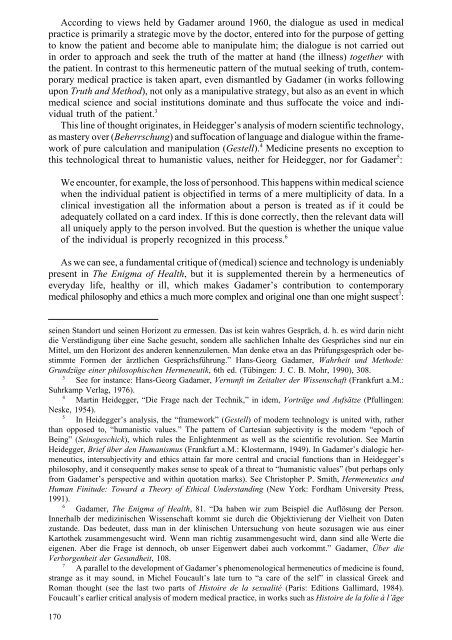[Andrzej_Wiercinski_(ed ... - WordPress.com
[Andrzej_Wiercinski_(ed ... - WordPress.com
[Andrzej_Wiercinski_(ed ... - WordPress.com
You also want an ePaper? Increase the reach of your titles
YUMPU automatically turns print PDFs into web optimized ePapers that Google loves.
According to views held by Gadamer around 1960, the dialogue as us<strong>ed</strong> in m<strong>ed</strong>icalpractice is primarily a strategic move by the doctor, enter<strong>ed</strong> into for the purpose of gettingto know the patient and be<strong>com</strong>e able to manipulate him; the dialogue is not carri<strong>ed</strong> outin order to approach and seek the truth of the matter at hand (the illness) together withthe patient. In contrast to this hermeneutic pattern of the mutual seeking of truth, contemporarym<strong>ed</strong>ical practice is taken apart, even dismantl<strong>ed</strong> by Gadamer (in works followingupon Truth and Method), not only as a manipulative strategy, but also as an event in whichm<strong>ed</strong>ical science and social institutions dominate and thus suffocate the voice and individualtruth of the patient. 3This line of thought originates, in Heidegger’s analysis of modern scientific technology,as mastery over (Beherrschung) and suffocation of language and dialogue within the frameworkof pure calculation and manipulation (Gestell). 4 M<strong>ed</strong>icine presents no exception tothis technological threat to humanistic values, neither for Heidegger, nor for Gadamer 5 :We encounter, for example, the loss of personhood. This happens within m<strong>ed</strong>ical sciencewhen the individual patient is objectifi<strong>ed</strong> in terms of a mere multiplicity of data. In aclinical investigation all the information about a person is treat<strong>ed</strong> as if it could beadequately collat<strong>ed</strong> on a card index. If this is done correctly, then the relevant data willall uniquely apply to the person involv<strong>ed</strong>. But the question is whether the unique valueof the individual is properly recogniz<strong>ed</strong> in this process. 6As we can see, a fundamental critique of (m<strong>ed</strong>ical) science and technology is undeniablypresent in The Enigma of Health, but it is supplement<strong>ed</strong> therein by a hermeneutics ofeveryday life, healthy or ill, which makes Gadamer’s contribution to contemporarym<strong>ed</strong>ical philosophy and ethics a much more <strong>com</strong>plex and original one than one might suspect 7 :seinen Standort und seinen Horizont zu ermessen. Das ist kein wahres Gespräch, d. h. es wird darin nichtdie Verständigung über eine Sache gesucht, sondern alle sachlichen Inhalte des Gespräches sind nur einMittel, um den Horizont des anderen kennenzulernen. Man denke etwa an das Prüfungsgespräch oder bestimmteFormen der ärztlichen Gesprächsführung.” Hans-Georg Gadamer, Wahrheit und Methode:Grundzüge einer philosophischen Hermeneutik, 6th <strong>ed</strong>. (Tübingen: J. C. B. Mohr, 1990), 308.3See for instance: Hans-Georg Gadamer, Vernunft im Zeitalter der Wissenschaft (Frankfurt a.M.:Suhrkamp Verlag, 1976).4Martin Heidegger, “Die Frage nach der Technik,” in idem, Vorträge und Aufsätze (Pfullingen:Neske, 1954).5In Heidegger’s analysis, the “framework” (Gestell) of modern technology is unit<strong>ed</strong> with, ratherthan oppos<strong>ed</strong> to, “humanistic values.” The pattern of Cartesian subjectivity is the modern “epoch ofBeing” (Seinsgeschick), which rules the Enlightenment as well as the scientific revolution. See MartinHeidegger, Brief über den Humanismus (Frankfurt a.M.: Klostermann, 1949). In Gadamer’s dialogic hermeneutics,intersubjectivity and ethics attain far more central and crucial functions than in Heidegger’sphilosophy, and it consequently makes sense to speak of a threat to “humanistic values” (but perhaps onlyfrom Gadamer’s perspective and within quotation marks). See Christopher P. Smith, Hermeneutics andHuman Finitude: Toward a Theory of Ethical Understanding (New York: Fordham University Press,1991).6Gadamer, The Enigma of Health, 81. “Da haben wir zum Beispiel die Auflösung der Person.Innerhalb der m<strong>ed</strong>izinischen Wissenschaft kommt sie durch die Objektivierung der Vielheit von Datenzustande. Das b<strong>ed</strong>eutet, dass man in der klinischen Untersuchung von heute sozusagen wie aus einerKartothek zusammengesucht wird. Wenn man richtig zusammengesucht wird, dann sind alle Werte dieeigenen. Aber die Frage ist dennoch, ob unser Eigenwert dabei auch vorkommt.” Gadamer, Über dieVerborgenheit der Gesundheit, 108.7A parallel to the development of Gadamer’s phenomenological hermeneutics of m<strong>ed</strong>icine is found,strange as it may sound, in Michel Foucault’s late turn to “a care of the self” in classical Greek andRoman thought (see the last two parts of Histoire de la sexualité (Paris: Editions Gallimard, 1984).Foucault’s earlier critical analysis of modern m<strong>ed</strong>ical practice, in works such as Histoire de la folie à l’ãge170


